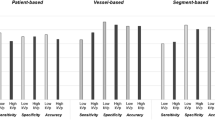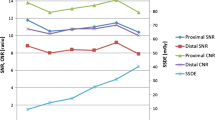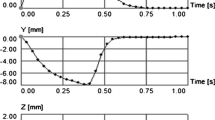Abstract
To evaluate the feasibility of an individually adapted coronary CT protocol based on precontrast attenuation values using different kVp and tube current settings. All images were acquired on a 64-slice CT scanner (Sensation 64, Siemens) in 270 consecutive patients. X-ray tube current and kVp settings were defined in 6 groups depending on the noise measurements at the heart level on pre-control unenhanced CT. The contrast medium was 400 mg/ml of iodine given at 1 ml/kg. The duration of injection was at 17 s in all cases, so the flow rate was adapted accordingly. Contrast enhancement and noise were measured from enhanced scans of the aortic root. The contrast to noise ratio (CNR) was used as an indicator of image quality. The mean contrast enhancement was 391 ± 83 HU. The mean radiation dose was 9.4 mSv (1.4–30.4 mSv). The mean noise was 39.8 ± 7.7 HU; noise was not significantly different between the groups, except for the 80 kVp group (mean noise = 54.5 HU, P < 0.05). The mean CNR was 10.1 ± 2.5, and CNR was similar in groups 1, 3, 4, and 5 (scanned at 80 kVp or 120 kVp), but significantly higher (CNR = 12) in group 2 (100 kVp) and significantly lower (CNR = 7.9) in group 6 (140 kVp). Individual adaptation of radiation dose is feasible in routine clinical coronary multislice CT, at various kVp and mAs settings. Image quality may be preserved with substantial radiation dose savings in patients with low attenuation values on precontrast images.


Similar content being viewed by others
References
Cademartiri F, Mollet NR, Lemos PA et al (2006) Higher intracoronary attenuation improves diagnostic accuracy in MDCT coronary angiography. AJR Am J Roentgenol 187(4):W430–W433
Kalender WA (2000) Computed tomography—fundamentals, system technology, image quality, applications. Publicis MCD Verlag, Erlangen
Sigal-Cinqualbre AB, Hennequin R, Abada HT et al (2004) Low-kilovoltage multi-detector row chest CT in adults: feasibility and effect on image quality and iodine dose. Radiology 231(1):169–174
Tatsugami F, Husmann L, Herzog BA et al (2009) Evaluation of a body mass index-adapted protocol for low-dose 64-MDCT coronary angiography with prospective ECG triggering. AJR Am J Roentgenol 192(3):635–638
Abada HT, Larchez C, Daoud B et al (2006) MDCT of the coronary arteries: feasibility of low-dose CT with ECG-pulsed tube current modulation to reduce radiation dose. AJR Am J Roentgenol 186(6 Suppl 2):S387–S390
Fujioka C, Horiguchi J, Kiguchi M et al (2009) Survey of aorta and coronary arteries with prospective ECG-triggered 100-kV 64-MDCT angiography. AJR Am J Roentgenol 193(1):227–233
Leschka S, Stinn B, Schmid F et al (2009) Dual source CT coronary angiography in severely obese patients: trading off temporal resolution and image noise. Invest Radiol 44(11):720–727
Zanzonico P, Rothenberg LN, Strauss HW (2006) Radiation exposure of computed tomography and direct intracoronary angiography: risk has its reward. J Am Coll Cardiol 47(9):1846–1849
Morin RL, Gerber TC, McCollough CH (2003) Radiation dose in computed tomography of the heart. Circulation 107(6):917–922
Das M, Mahnken AH, Muhlenbruch G et al (2005) Individually adapted examination protocols for reduction of radiation exposure for 16-MDCT chest examinations. AJR Am J Roentgenol 184(5):1437–1443
Gamsu G, Held BT, Czum JM (2004) Reduced radiation for adult thoracic CT: a practical approach. J Thorac Imaging 19(2):93–97
Tack D, De Maertelaer V, Gevenois PA (2003) Dose reduction in multidetector CT using attenuation-based online tube current modulation. AJR Am J Roentgenol 181(2):331–334
Jung B, Mahnken AH, Stargardt A et al (2003) Individually weight-adapted examination protocol in retrospectively ECG-gated MSCT of the heart. Eur Radiol 13(12):2560–2566
Paul JF, Wartski M, Caussin C, Sigal-Cinqualbre A, Lancelin B, Angel C, Dambrin G (2005) Late defect on delayed contrast-enhanced multi-detector row CT scans in the prediction of SPECT infarct size after reperfused acute myocardial infarction: initial experience. Radiology 236:485–489
Mahnken AH, Koos R, Katoh M, Wildberger JE, Spuentrup E, Buecker A, Gunther RW, Kuhl HP (2005) Assessment of myocardial viability in reperfused acute myocardial infarction using 16-slice computed tomography in comparison to magnetic resonance imaging. J Am Coll Cardiol 45:2042–2047
Brodoefel H, Klumpp B, Reimann A, Ohmer M, Fenchel M, Schroeder S, Miller S, Claussen C, Kopp AF, Scheule AM (2007) Late myocardial enhancement assessed by 64-MSCT in reperfused porcine myocardial infarction: diagnostic accuracy of low-dose CT protocols in comparison with magnetic resonance imaging. Eur Radiol 17(2):475–483
d’Agostino AG, Remy-Jardin M, Khalil C et al (2006) Low-dose ECG-gated 64-slices helical CT angiography of the chest: evaluation of image quality in 105 patients. Eur Radiol 16(10):2137–2146
EC99 (1999) European guidelines on quality criteria for computed tomography. Report EUR 16262. European Commission, Brussels
Hausleiter J, Meyer T, Hadamitzky M et al (2006) Radiation dose estimates from cardiac multislice computed tomography in daily practice: impact of different scanning protocols on effective dose estimates. Circulation 113(10):1305–1310
Poll LW, Cohnen M, Brachten S et al (2002) Dose reduction in multi-slice CT of the heart by use of ECG-controlled tube current modulation (“ECG pulsing”): phantom measurements. Rofo 174(12):1500–1505
Gerber TC, Kuzo RS, Morin RL (2005) Techniques and parameters for estimating radiation exposure and dose in cardiac computed tomography. Int J Cardiovasc Imaging 21(1):165–176
Trabold T, Buchgeister M, Kuttner A et al (2003) Estimation of radiation exposure in 16-detector row computed tomography of the heart with retrospective ECG-gating. Rofo 175(8):1051–1055
Hunold P, Vogt FM, Schmermund A et al (2003) Radiation exposure during cardiac CT: effective doses at multi-detector row CT and electron-beam CT. Radiology 226(1):145–152
Coles DR, Smail MA, Negus IS et al (2006) Comparison of radiation doses from multislice computed tomography coronary angiography and conventional diagnostic angiography. J Am Coll Cardiol 47(9):1840–1845
Conflict of interest
None.
Author information
Authors and Affiliations
Corresponding author
Rights and permissions
About this article
Cite this article
Paul, JF. Individually adapted coronary 64-slice CT angiography based on precontrast attenuation values, using different kVp and tube current settings: evaluation of image quality. Int J Cardiovasc Imaging 27 (Suppl 1), 53–59 (2011). https://doi.org/10.1007/s10554-011-9960-9
Received:
Accepted:
Published:
Issue Date:
DOI: https://doi.org/10.1007/s10554-011-9960-9




